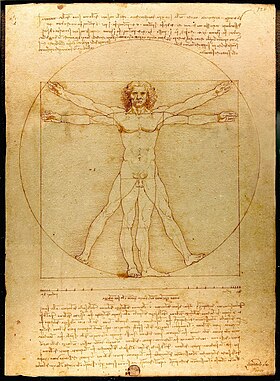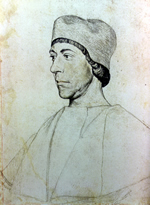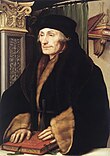Christian humanism

"In his explicit turn back to an ancient model in search of knowledge and wisdom, Leonardo follows early humanist practice. What he finds in Vitruvius is a mathematical formula for the proportions of all parts of the human body, which results in its idealized representation as the true microcosmic measure of all things. [...]The perfection of this ideal human form corresponds visually to the early humanist belief in the unique central placement of human beings within the divine universal order and their consequent human grandeur and dignity, expressed in the philosopher Pico della Mirandola's Oration on the Dignity of Man (1486), known as the manifesto of the Renaissance."
— Anne Hudson Jones[1]
Christian humanism regards classical humanist principles such as universal human dignity, individual freedom, and the importance of happiness as essential and principal or even exclusive components of the teachings of Jesus.
Proponents of the term trace the concept to the Renaissance, linking their beliefs to the scholarly movement and worldview often called just humanism.[2]
Terminology
[edit]Historian Margaret Mann Phillips wrote that the basis of Christian humanism was "the belief that all that is good comes from God, and the pre-Christian ages were inspired by Holy Spirit for his own purposes."[3]: 9
In the Renaissance, the initial distinguishing factor between Christian humanism and other varieties of humanism was that Christian humanists not only discussed religious or theological issues in some or all of their works (as did all Renaissance humanists) but according to Charles Nauert,
made a connection between their humanistic teaching and scholarship on classical languages and literature, on the one hand, and on the other hand, their study of ancient Christianity, including the Bible and the Church Fathers... Even more important, they associated their scholarly work (classical as well as biblical and patristic) with a determination to bring about a spiritual renewal and institutional reform of Christian society. That connection between their scholarly efforts and their longing for spiritual and institutional renewal is the specific characteristic that distinguishes "Christian humanists" as a group from other humanists who just happened to be religious.[4]
Modern theologians such as Jens Zimmerman make a case for the concept of Christian humanism as a cogent force throughout the history of Christianity. In Zimmerman's account, Christian humanism as a tradition emerges from the Christian doctrine that God, in the person of Jesus, became human in order to redeem humanity, and from the further injunction for the participating human collective (the church) to act out the life of Christ.[5]
The term has been criticized by figures associated with the modern secular humanist movement, with some noting that it lacks coherence, or is in fact used to argue for the "exceptionalism" of Christianity.
Some modern Christian humanists, for example, go so far as to suggest that other understandings of humanism are inauthentic, saying that, "common humanity, universal reason, freedom, personhood, human rights, human emancipation and progress, and indeed the very notion of secularity... are literally unthinkable without their Christian humanistic roots."[6][7][8]
History
[edit]Renaissance
[edit]Scholars since the 18th century have agreed that some sort of change took place in Western European civilization in the period from 1300 to 1600. However, the extent and nature of this change have been widely debated. Some have seen the period as one in which a radically new sense of the world and humanity emerged, whereas others have seen instead the gradual development of ideas that had long been current. Nevertheless, there are elements in Renaissance thought that recur frequently in comparison to earlier centuries. In the Middle Ages, people typically yielded some of their identity to corporations—the church, the state, the feudal society, the guild, the university, and the monastic order. With the Renaissance came an increased sense of individuality and a celebration of uniqueness and individual self-determination. The literature of the period is filled with statements such as the following about the dignity, excellence, rationality, and power of individual human beings:[9]
- Human beings are made "in the image of God", meaning that each one has the possibility of being a person of creativity and moral excellence.
- Human beings are free; we are not enslaved by sin or psychological obstructions; we are able to set our own course, determine our own destiny.
- Human beings are actors on the human scene; we are creators, second only to God; we are the God-appointed governors of the world.
- Human beings have immortal souls, which is God's way of verifying the preciousness of humankind.
- Human beings may achieve fame—the personal glory attained by an individual who thrusts himself or herself forward in some important, heroic, or prominent way.
Renaissance humanism is linked to those who, following Pico della Mirandola, emphasized the dignity and potential of created humankind. And those, such as Petrarch and Thomas More, who believed the humanities could aid the precepts and study of divinity. And those such as Erasmus who also promoted human flourishing.
Origins
[edit]Christian humanism originated towards the end of the 15th century with the early work of figures such as Jakob Wimpfeling, John Colet, and Thomas More; it would go on to dominate much of the thought in the first half of the 16th century with the emergence of widely influential Renaissance and humanistic intellectual figures such as Jacques Lefèvre d'Étaples and especially Erasmus, who would become the greatest scholar of the northern Renaissance.[4] These scholars committed much of their intellectual work to reforming the church and reviving spiritual life through humanist education, and were highly critical of the corruption they saw in the Church and ecclesiastical life. They would combine the greatest morals in the pre-Christian moral philosophers, such as Cicero and Seneca with Christian interpretations deriving from study of the Bible and Church Fathers. The Waldensians have been viewed as a humanistic synthesis of Christianity.[10]
Jakob Wimpfeling
[edit]Although the first humanists did little to orient their intellectual work towards reforming the church and reviving spiritual life through humanist education, the first pioneering signs and practices of this idea emerged with Jakob Wimpfeling (1450–1528), a Renaissance humanist and theologian. Wimpfeling was very critical of ecclesiastical patronage and criticized the moral corruption of many clergymen; however, his timidity stopped him from converting his work from speech to action for fear of controversy. Although he loved reading many of the classics of the writings of classical antiquity, he feared introducing them to mainstream Christianity and sought to use the works of the Latin Church Fathers and a few Christian poets from the Late Roman Empire towards creating a new form of education that would provide church leaders educated in Christian religion, prominent Church authors and a few important classical writings and hence improve Christendom's condition.[4]: 170–171
John Colet
[edit]
John Colet (1467–1519) was another major figure in early Christian humanism, exerting more cultural influence than his older contemporary, Jakob Wimpfeling. Being attracted to Neoplatonic philosophers such as Marsilio Ficino and Pico della Mirandola and gaining an appreciation for humanistic methods of analyzing texts and developing detailed ideas and principles regarding them, he applied this humanistic method to the epistles of Paul the Apostle.
In 1505, he completed his doctorate in theology, and then became the Dean of St. Paul's Cathedral. From there, he used his fortune to found near the cathedral St Paul's School for boys. The school was humanistic, in its teaching of Latin, Greek and moral preparation of its students, as well as its recruitment of prominent humanists to recommend and compose new textbooks for it. The best Christian authors were taught, as well as a handful of pagan texts (predominantly Cicero and Virgil), however, Colet's restrictions on the teaching of other classical texts was seen as anti-humanistic and quickly reverted by the school's headmasters. After his death, the school at St. Paul's become an influential humanistic institution.[4]: 170–171 His notable convocation sermon urged his fellow priests to "return to the God of love and peace".
Jacques Lefèvre d'Étaples
[edit]Jacques Lefèvre d'Étaples (1453–1536) was, alongside Erasmus, the first of the great Christian humanists to see the importance of integrating Christian learning, in both the patristics and biblical writings, with many of the best intellectual achievements of ancient civilizations and classical thought. He was educated in the University of Paris and began studying Greek under George Hermonymus due to his interest in contemporary cultural changes in Italy. He taught humanities as Paris and, among his earliest scholarly works, was writing an introduction to Aristotle's Metaphysics. He would write many other works on Aristotle and promote the use of direct translations of Aristotle's work from the original Greek rather than the medieval Latin translations that currently existed.
His focus then began to shift to the Greek Church Fathers whom he personally considered abler sources for the pedagogy of spiritual life than medieval scholasticism, and his goal became to help revive spiritual life in Europe, retiring in 1508 to focus on precisely this. He began publishing various Latin texts of biblical books such as the Psalms and Pauline epistles and was keen to study textual variations between surviving manuscripts. According to Nauert, these "biblical publications constitute the first major manifestation of the Christian humanism that dominated not only French but also German, Netherlandish, and English humanistic thought through the first half of the sixteenth century".[11][12]
Erasmus
[edit]
Erasmus (1466–1536) was the greatest scholar of the northern Renaissance and the most widely influential Christian humanist scholar in history, becoming the most famous scholar in Europe in his day. He believed that "learning and scholarship were a powerful weapon both for the cultivation of personal piety and institutional church reform", which is called instrumentalism.[13]: 153
One of the defining components of his intellectual success was his mastery of Greek.[14]
He had published his Handbook of a Christian Knight (Enchiridion militis christiani) in 1503, writing about his new intellectual direction, the philosophia christi ('Christ's philosophy'). It became incredibly popular with 29 Latin editions between 1519–1523 and receiving translations into English, Dutch, German, French, and Spanish.[15]
The popularity of Erasmus and his work was further amplified by the success of his literary works such as The Praise of Folly, published in 1511, and Colloquies, published in 1518. He also gained incredible success as a textual scholar, interpreting, translating and editing numerous texts of Greek and Roman classics, Church Fathers and the Bible. This textual success began when he discovered and published Lorenzo Valla's Annotations on the New Testament in 1504–1505, and in a single year, in 1516, Erasmus published the first Greek edition of the New Testament, an edition of the works of the Roman philosopher Seneca, and a four-volume edition of St. Jerome's letters. His satires and criticisms were widely popular and renowned for decades to come, and he succeeded in having "truly and fully" founded Christian humanism.[4]: 180
Contemporary
[edit]Literary critic Lee Oser has suggested that Christian humanism ended with Jonathan Swift and Alexander Pope; however, it began again with G.K. Chesterton, T.S. Eliot and J.R.R. Tolkien.[16]
Personalism, an intellectual stance that emphasizes the importance of human persons, has been treated as a modern name for the Christian humanism associated with Pope John Paul II and John Henry Newman.[13]: 157–164
Incarnational humanism is a type of Christian humanism which places central importance on the Incarnation, the belief that Jesus Christ was truly and fully human. In this context, divine revelation from God independent of the Incarnation is seen as untrustworthy precisely because it is exempt from the vagaries of human discourse.
Jens Zimmermann argues that "God's descent into human nature allows the humans ascent to the divine".[17][dead link] "If God speaks to us in the language of humanity, then we must interpret Gods speech as we interpret the language of humanity."[18] Incarnational humanism asserts a unification of the secular and the sacred with the goal of a common humanity. This unification is fully realized in the participatory nature of Christian sacraments, particularly the Eucharist. The recognition of this goal requires a necessary difference between the church and the world, where both "spheres are unified in their service of humanity". Critics suggest it is quite wrong to establish a separate theology of the incarnation, and that proponents tend to abstract Jesus from his life and message.
Criticism
[edit]Andrew Copson refers to Christian humanism as a "hybrid term... which some from a Christian background have been attempting to put into currency". Copson argues that attempts to append religious adjectives such as Christian to the life stance of humanism are incoherent, saying these have "led to a raft of claims from those identifying with other religious traditions – whether culturally or in convictions – that they too can claim a 'humanism'. The suggestion that has followed – that 'humanism' is something of which there are two types, 'religious humanism' and 'secular humanism', has begun to seriously muddy the conceptual water."[19]
See also
[edit]References
[edit]- ^ Hudson Jones, Anne. "Neh Institute". uva.theopenscholar.com.
- ^ Rummel, Erika; MacPhail, Eric (2024). "Desiderius Erasmus". The Stanford Encyclopedia of Philosophy. Metaphysics Research Lab, Stanford University.
- ^ Erasmus, Desideriushg (1978). Literary and Educational Writings, 1 and 2: Volume 1: Antibarbari / Parabolae. Volume 2: De copia / De ratione studii, Volume 23-24. Vol. 23–24. University of Toronto Press. doi:10.3138/9781442676695. ISBN 978-0-8020-5395-4. JSTOR 10.3138/9781442676695.
- ^ a b c d e Nauert, Charles, Rethinking "Christian Humanism" in Mazzocco, Angelo, ed. Interpretations of Renaissance humanism. Brill, 2006, 155-180.
- ^ Zimmerman, Jens. "Introduction", in Zimmermann, Jens, ed. Re-Envisioning Christian Humanism. Oxford University Press, 2017, 5.
- ^ Zimmermann, 6-7.
- ^ Croce, Benedetto Croce. My Philosophy and Other Essays on the Moral and Political Problems of Our Time (London: Allen & Unwin, 1949).
- ^ Zimmermann, Jens. Humanism and Religion: A Call for the Renewal of Western Culture. Oxford University Press, 2012.
- ^ Thompson, Bard (January 1, 1996). Humanists and Reformers: A History of the Renaissance and Reformation. William B. Eerdmans Publishing Company. pp. 3–4. ISBN 978-0802863485.
- ^ Bernholz, P.; Streit, M.E.; Vaubel, R. (2012). Political Competition, Innovation and Growth: A Historical Analysis. Springer Berlin Heidelberg. p. 167. ISBN 978-3-642-60324-2. Retrieved 2023-03-05.
- ^ Rice Jr, Eugene F. "The Humanist Idea of Christian Antiquity: Lefèvre d'Etaples and his Circle". Studies in the Renaissance 9 (1962): 126-160.
- ^ Nauert, 173-174.
- ^ a b Cunningham, Lawrence S. (1 March 2002). The Catholic Heritage: Martyrs, Ascetics, Pilgrims, Warriors, Mystics, Theologians, Artists, Humanists, Activists, Outsiders, and Saints. Wipf and Stock Publishers. ISBN 978-1-57910-897-7.
- ^ Erasmus to Batt, Orléans, 11 December 1500, Ep. 138 (CWE 1:294–300; Allen 1:320–24).
- ^ Anne M. O'Donnell, 'Rhetoric and Style in Erasmus' Enchiridion militis Christiani', Studies in Philology 77/1 (1980), 26.
- ^ Blackstock, Alan (2009). "Review of The Return of Christian Humanism: Chesterton, Eliot, Tolkien, and the Romance of History". Rocky Mountain Review. 63 (2): 266–272. ISSN 1948-2825. JSTOR 25594413.
- ^ "Incarnational Humanism: A Philosophy of Culture for the Church in the World". University of Waterloo. Retrieved 5 April 2019.
- ^ "The doctrine of the Incarnation By David Gibson". Commonweal. 29 December 2011. Retrieved 5 April 2019.
- ^ Copson, Andrew, and Anthony Clifford Grayling, eds. The Wiley Blackwell handbook of humanism. John Wiley & Sons, 2015, 2-3. Chapter: What is Humanism?
Further reading
[edit]- Bequette, John P. Christian Humanism: Creation, Redemption, and Reintegration. University Press of America, 2007.
- Erasmus, Desiderius, and Beatus Rhenanus. Christian Humanism and the Reformation: Selected Writings of Erasmus, with His Life by Beatus Rhenanus and a Biographical Sketch by the Editor. Fordham Univ Press, 1987.
- Jacobs, Alan. The Year of Our Lord 1943: Christian Humanism in an Age of Crisis. Oxford University Press, 2018.
- Oser, Lee. "Christian Humanism and the Radical Middle". Law & Liberty. November 5, 2021. https://lawliberty.org/christian-humanism-and-the-radical-middle/
- Oser, Lee. Christian Humanism in Shakespeare: A Study in Religion and Literature. Catholic University of America Press, 2022.
- Oser, Lee. The Return of Christian Humanism: Chesterton, Eliot, Tolkien, and the Romance of History. University of Missouri Press, 2007.
- Shaw, Joseph et al. Readings in Christian humanism. Fortress Press, 1982.
- Zimmermann, Jens. Humanism and Religion: A Call for the Renewal of Western Culture. Oxford University Press, 2012.
- Zimmermann, Jens. Re-Envisioning Christian Humanism. Oxford University Press, 2017.
External links
[edit]- No Christian humanism? Big mistake. Archived 2019-02-18 at the Wayback Machine, Online Catholics, by Peter Fleming. (Accessed 6 May 2012)


 French
French Deutsch
Deutsch




